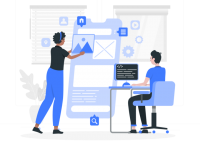Unlocking Growth with Digital Transformation Technologies: Strategies, Tools & Market Insights
The Rise of Digital Transformation Technologies
In today’s competitive business environment, digital transformation technologies are no longer an option—they are a necessity. Whether you're a startup scaling operations or an enterprise modernizing legacy systems, integrating the right technologies can redefine the way you operate, interact, and grow. With AI automation at the forefront, the journey toward digital maturity is reshaping how businesses deliver value to customers and stakeholders alike.
What Are Digital Transformation Technologies?
Digital transformation technologies refer to the advanced tools and platforms that enable businesses to digitize operations, automate workflows, enhance customer experience, and unlock data-driven insights. These include:
Artificial Intelligence (AI) & Machine Learning (ML)
Robotic Process Automation (RPA)
Cloud Computing & SaaS Platforms
Data Analytics and Big Data
Internet of Things (IoT)
Blockchain
Cybersecurity Solutions
Low-code/No-code Development Platforms
Digital Twins & Simulation Tools
These tools are foundational to a company’s shift from traditional methods to digital-first operations.
Techniques and Strategies for Digital Transformation
Implementing digital transformation requires a clear roadmap, integrating both people and technology. Here are the core techniques and strategies that successful organizations are adopting:
1. Customer-Centric Innovation
Place customer needs at the core of your transformation efforts. Tools like AI-powered chatbots, CRM systems, and personalized marketing platforms can help businesses tailor experiences and foster loyalty.
2. Process Automation
Automation is a game changer for repetitive, rule-based tasks. RPA tools like UiPath or Automation Anywhere improve operational efficiency and reduce human error.
3. Cloud Migration
Moving infrastructure and applications to the cloud (via AWS, Azure, or Google Cloud) ensures scalability, cost optimization, and real-time data access from anywhere.
4. Agile Implementation
Instead of a massive overhaul, adopt an agile approach—start with pilot projects, gather feedback, scale what works. This minimizes disruption while maximizing value.
5. Data-Driven Decision-Making
Adopt tools like Power BI, Tableau, or Google Looker to unlock actionable insights from your business data. Data analytics allows companies to forecast trends and refine strategies.
6. Cybersecurity Integration
With digitization comes risk. Implement cybersecurity from day one. Use tools like firewalls, intrusion detection systems, and zero-trust architectures to safeguard data and privacy.



